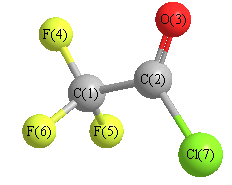Vibrational Frequencies calculated at HF/6-31G*
| Mode Number |
Symmetry |
Frequency
(cm-1) |
Scaled Frequency
(cm-1) |
IR Intensities
(km mol-1) |
Raman Act
(Å4/u) |
Dep P |
Dep U |
|---|
| 1 |
A' |
2101 |
1888 |
330.57 |
|
|
|
| 2 |
A' |
1464 |
1315 |
103.30 |
|
|
|
| 3 |
A' |
1431 |
1286 |
292.67 |
|
|
|
| 4 |
A' |
1045 |
939 |
330.22 |
|
|
|
| 5 |
A' |
820 |
737 |
84.38 |
|
|
|
| 6 |
A' |
637 |
572 |
9.79 |
|
|
|
| 7 |
A' |
567 |
509 |
13.36 |
|
|
|
| 8 |
A' |
446 |
401 |
1.20 |
|
|
|
| 9 |
A' |
372 |
334 |
3.18 |
|
|
|
| 10 |
A' |
214 |
192 |
2.20 |
|
|
|
| 11 |
A" |
1398 |
1256 |
313.54 |
|
|
|
| 12 |
A" |
786 |
706 |
8.31 |
|
|
|
| 13 |
A" |
556 |
499 |
11.61 |
|
|
|
| 14 |
A" |
256 |
230 |
6.88 |
|
|
|
| 15 |
A" |
49 |
44 |
0.78 |
|
|
|
Unscaled Zero Point Vibrational Energy (zpe) 6070.8 cm
-1
Scaled (by 0.8985) Zero Point Vibrational Energy (zpe) 5454.6 cm
-1
See section
III.C.1 List or set vibrational scaling factors
to change the scale factors used here.
See section
III.C.2
Calculate a vibrational scaling factor for a given set of molecules
to determine the least squares best scaling factor.
Charges, Dipole, Quadrupole and Polarizability
Charges from optimized geometry at HF/6-31G*
Charges (e)
| Number |
Element |
Mulliken |
CHELPG |
AIM |
ESP |
| 1 |
C |
1.090 |
|
|
|
| 2 |
C |
0.269 |
|
|
|
| 3 |
O |
-0.389 |
|
|
|
| 4 |
F |
-0.327 |
|
|
|
| 5 |
F |
-0.337 |
|
|
|
| 6 |
F |
-0.337 |
|
|
|
| 7 |
Cl |
0.032 |
|
|
|
Electric dipole moments
Electric dipole components in Debye
(What's a Debye? See section
VII.A.3)
| |
x |
y |
z |
Total |
| |
-0.670 |
-0.635 |
0.000 |
0.923 |
| CHELPG |
|
|
|
|
| AIM |
|
|
|
|
| ESP |
|
|
|
|
Electric Quadrupole moment
Quadrupole components in D Å
| Primitive |
|---|
| | x | y | z |
|---|
| x |
-44.398 |
-1.577 |
0.000 |
| y |
-1.577 |
-46.972 |
0.000 |
| z |
0.000 |
0.000 |
-42.801 |
|
| Traceless |
|---|
| | x | y | z |
|---|
| x |
0.488 |
-1.577 |
0.000 |
| y |
-1.577 |
-3.372 |
0.000 |
| z |
0.000 |
0.000 |
2.884 |
|
| Polar |
|---|
| 3z2-r2 | 5.768 |
|---|
| x2-y2 | 2.574 |
|---|
| xy | -1.577 |
|---|
| xz | 0.000 |
|---|
| yz | 0.000 |
|---|
|
Polarizabilities
Components of the polarizability tensor.
Units are
Å
3 (Angstrom cubed)
Change units.
| |
x |
y |
z |
| x |
6.120 |
0.053 |
0.000 |
| y |
0.053 |
4.332 |
0.000 |
| z |
0.000 |
0.000 |
3.200 |
<r2> (average value of r
2) Å
2
| <r2> |
212.821 |
| (<r2>)1/2 |
14.588 |
